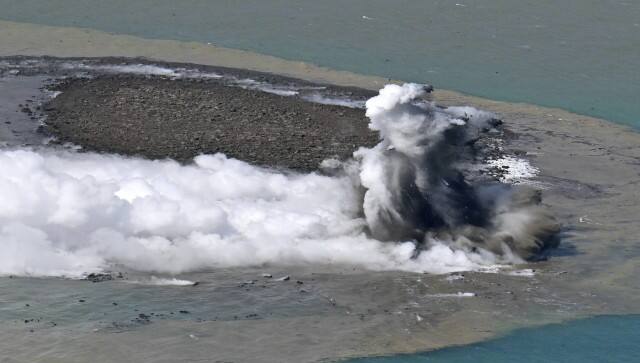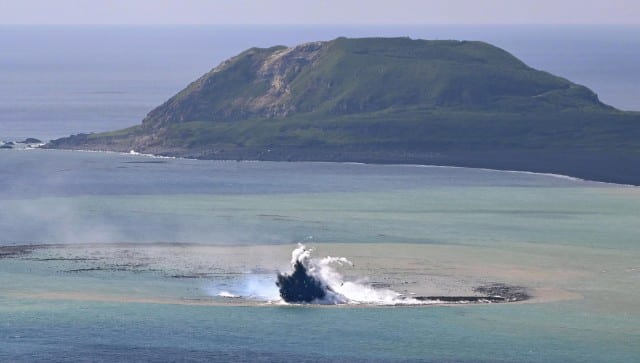In the Pacific Ocean, off the shore of the Japan’s Iwo Jima island, a new island has emerged from the water. The unnamed island was created by an underwater volcanic eruption, according to Japan’s Meteorological Agency (JMA), which spoke with CNN. Let’s take a closer look at its formation. Japan gets a new island According to The Guardian, the island is located roughly 1,200 kilometres (745 miles) south of mainland Japan and one kilometre from Iwo Jima, an active volcano in the south of Ogasawara Island that witnessed some of the most intense battles of World War II. Since 21 October, JMA reported that volcanic tremors have been felt on Iwo Jima every few minutes, followed by eruptions off the southern shore. [caption id=“attachment_13368732” align=“alignnone” width=“640”] A new island, 100 meters in diameter, formed by erupted rock, is seen near the steam, according to Kyodo News. AP[/caption] The nation’s Maritime Self-Defense Force captured images of the new island emerging from the water on 1 November. The tiny island, which is currently a member of the Ogasawara Island group, is seen in the pics to have had a small eruption that sent a thick cloud of ash above it. Although the JMA has been monitoring the region for volcanic activity since last year, the University of Tokyo’s Earthquake Research Institute has established that the island-forming eruption occurred on 30 October. The remarkable formation According to experts, the isle formed as a result of many eruptions that started in October close to Iwoto island. Setsuya Nakada, an emeritus professor of volcanology at the University of Tokyo, told the Japan Times that magma had been developing beneath the surface for some time before to its ultimate eruption on 30 October. However, according to him, the new island formed after the solidified magma that had been building up began to break the surface.
A new island, 100 meters in diameter, formed by erupted rock, is seen near the steam, according to Kyodo News. AP[/caption] The nation’s Maritime Self-Defense Force captured images of the new island emerging from the water on 1 November. The tiny island, which is currently a member of the Ogasawara Island group, is seen in the pics to have had a small eruption that sent a thick cloud of ash above it. Although the JMA has been monitoring the region for volcanic activity since last year, the University of Tokyo’s Earthquake Research Institute has established that the island-forming eruption occurred on 30 October. The remarkable formation According to experts, the isle formed as a result of many eruptions that started in October close to Iwoto island. Setsuya Nakada, an emeritus professor of volcanology at the University of Tokyo, told the Japan Times that magma had been developing beneath the surface for some time before to its ultimate eruption on 30 October. However, according to him, the new island formed after the solidified magma that had been building up began to break the surface.
“In an earlier stage, a vertical jet of black colour, debris — which is a solidified magma — and water gushed upward,” Nakada said, adding, “Since Nov. 3, the eruption started changing and the emission of volcanic ash continued explosively.” Comprising of piles of pumice, the isle erodes swiftly. But according to Nakada, there is a good probability the isle will survive as long as there is volcanic activity since the lava flow will shield it. “The areas that don’t have lava could be scraped away. So if more and more lava comes out, and covers the area, I think that part will remain forever,” Nakada told the Japanese outlet, adding that it is unclear whether the eruption will continue. “There is a possibility that the (new) island could merge with Iwo Jima (also known as Iwoto Island) if the eruption continues,” he said. Fukashi Maeno, an associate professor at Tokyo University’s earthquake research institute, told Kyodo News that the recent developmnt was proof that magmatic activity had returned to the region. If the eruptions continue, the new island may expand and take on new forms, but it may also vanish beneath the seas. [caption id=“attachment_13368772” align=“alignnone” width=“640”] This aerial photo shows steam billowing from the waters off Iwoto Island, Ogasawara town in the Pacific Ocean. AP[/caption] Similar geological events In 2013, following many weeks of volcanic activity, Nishinoshima island in the Ogasawara chain merged with another island, as per the Japan Times. A volcanic explosion that occurred underwater also formed Nishinoshima, which eventually grew to a diameter of almost two kilometres. As per Guardian, Japan was initially believed to have four large and roughly 6,000 smaller islands. However, thanks to digital mapping technology, the Japanese Geospatial Information Authority said that tge country was home to over 14,125 islands. Japan sometimes gets additional islands, but it also loses some. Islands that originated in the same manner in the region in 1904, 1914, and 1986 all vanished as a result of erosion. In 2018, it is believed that Esanbe Hanakita Kojima, 500 metres off the shore of Hokkaido, disappeared under the waves without anybody noticing. Nobody knew it had vanished until Hiroshi Shimizu, a writer, travelled to the region to create a follow-up to his picture book about Japan’s “hidden” islands. Though continuous volcanic activity could result in lava flows that eventually form a stronger, more durable surface, new islands composed of ash and rock fragments might find it difficult to withstand ongoing wave hammering. With inputs from agencies
This aerial photo shows steam billowing from the waters off Iwoto Island, Ogasawara town in the Pacific Ocean. AP[/caption] Similar geological events In 2013, following many weeks of volcanic activity, Nishinoshima island in the Ogasawara chain merged with another island, as per the Japan Times. A volcanic explosion that occurred underwater also formed Nishinoshima, which eventually grew to a diameter of almost two kilometres. As per Guardian, Japan was initially believed to have four large and roughly 6,000 smaller islands. However, thanks to digital mapping technology, the Japanese Geospatial Information Authority said that tge country was home to over 14,125 islands. Japan sometimes gets additional islands, but it also loses some. Islands that originated in the same manner in the region in 1904, 1914, and 1986 all vanished as a result of erosion. In 2018, it is believed that Esanbe Hanakita Kojima, 500 metres off the shore of Hokkaido, disappeared under the waves without anybody noticing. Nobody knew it had vanished until Hiroshi Shimizu, a writer, travelled to the region to create a follow-up to his picture book about Japan’s “hidden” islands. Though continuous volcanic activity could result in lava flows that eventually form a stronger, more durable surface, new islands composed of ash and rock fragments might find it difficult to withstand ongoing wave hammering. With inputs from agencies
)